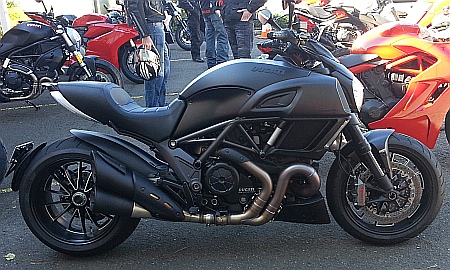 The Diavel isn’t Ducati’s first attempt at a cruiser, but it’s the first one for quite a while. And it shows what the Italian manufacturer thinks cruisers should be. No Harley-clone for them; oh, no! The way they went was to build a cruiser-type chassis and body, then drop in a detuned superbike engine. And no twin-shocks at the back either – no, they put in a progressive-rate mono-shock that owes more to sports-bike design than to cruisers. Oh, and they made sure to put the pegs up high so there’s plenty of cornering clearance. And there you have it – the Ducati Diavel!
The Diavel isn’t Ducati’s first attempt at a cruiser, but it’s the first one for quite a while. And it shows what the Italian manufacturer thinks cruisers should be. No Harley-clone for them; oh, no! The way they went was to build a cruiser-type chassis and body, then drop in a detuned superbike engine. And no twin-shocks at the back either – no, they put in a progressive-rate mono-shock that owes more to sports-bike design than to cruisers. Oh, and they made sure to put the pegs up high so there’s plenty of cornering clearance. And there you have it – the Ducati Diavel!
 You might have heard that the word “diavel” in Italian means “devil”. It does. So why did Ducati call their bike “Devil”? It’s an interesting story.
You might have heard that the word “diavel” in Italian means “devil”. It does. So why did Ducati call their bike “Devil”? It’s an interesting story.
 During the development process, when the prototype was assembled and wheeled out in front of a group of Ducati technicians for the first time, one bloke looking at it from the rear saw its silhouette and exclaimed in Bolognese dialect, “Ignurànt comm' al diavel!” which means, “Evil, like the devil!” From then on, “Diavel” became the nickname around the factory for the project, and Ducati ended up keeping it as the official name. By the way, the name is pronounced, “dee-Avil”. (Not “di-a-vil” as I had been pronouncing it!).
During the development process, when the prototype was assembled and wheeled out in front of a group of Ducati technicians for the first time, one bloke looking at it from the rear saw its silhouette and exclaimed in Bolognese dialect, “Ignurànt comm' al diavel!” which means, “Evil, like the devil!” From then on, “Diavel” became the nickname around the factory for the project, and Ducati ended up keeping it as the official name. By the way, the name is pronounced, “dee-Avil”. (Not “di-a-vil” as I had been pronouncing it!).
 At a basic level, the bike is typical Ducati – a tubular steel trellis frame and an L-twin engine running Ducati’s usual desmodromic valve system. In other ways though, it is not what we typically expect from Ducati. The bike has a long, low profile, with raked-out front, leaving no doubt that it is Ducati’s idea of a cruiser. But it’s a cruiser with over 110kW, and heaps of ground-clearance. Ah, yes, you can take the bike out of Italy, but you can’t take Italy out of the bike!
At a basic level, the bike is typical Ducati – a tubular steel trellis frame and an L-twin engine running Ducati’s usual desmodromic valve system. In other ways though, it is not what we typically expect from Ducati. The bike has a long, low profile, with raked-out front, leaving no doubt that it is Ducati’s idea of a cruiser. But it’s a cruiser with over 110kW, and heaps of ground-clearance. Ah, yes, you can take the bike out of Italy, but you can’t take Italy out of the bike!
IN THE DRIVEWAY
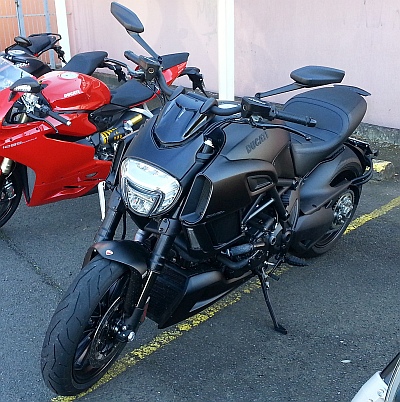
 Looking at the bike it is obviously a cruiser; but it’s different. It looks mean, and, well, devil-ish!
Looking at the bike it is obviously a cruiser; but it’s different. It looks mean, and, well, devil-ish!
 The sides of the bike are dominated by huge brushed-aluminium air-ducts that funnel air down into the motor, and give the bike an angry purposeful look. It looks aggressive, which is appealing in its own way, but I wouldn’t call it stylish exactly. Looked at side-on there are bits going everywhere – the bulging tank and the frame curving downwards, the snaking exhaust with the huge trumpets on the end, and the seat which has the rider perched almost above the back wheel. And that arm that reaches around behind the back wheel to display the number-plate looks a bit weird I reckon. (I don’t like those one-sided arm things!).
The sides of the bike are dominated by huge brushed-aluminium air-ducts that funnel air down into the motor, and give the bike an angry purposeful look. It looks aggressive, which is appealing in its own way, but I wouldn’t call it stylish exactly. Looked at side-on there are bits going everywhere – the bulging tank and the frame curving downwards, the snaking exhaust with the huge trumpets on the end, and the seat which has the rider perched almost above the back wheel. And that arm that reaches around behind the back wheel to display the number-plate looks a bit weird I reckon. (I don’t like those one-sided arm things!).
 The front is dominated by the big headlight that bulges out from the bike. Inside the big glass structure is an LCD lamp system. At the back, there are twin vertical LED strips, which serve all the usual rear-light functions – brake, taillight, and blinkers.
The front is dominated by the big headlight that bulges out from the bike. Inside the big glass structure is an LCD lamp system. At the back, there are twin vertical LED strips, which serve all the usual rear-light functions – brake, taillight, and blinkers.
 As for the colour of the bike, well, I’m not a fan of matte-black. As my wife said when she saw my photo of it, “Did they forget to polish it!?” I’m not that generous; I reckon it looks like undercoat!
As for the colour of the bike, well, I’m not a fan of matte-black. As my wife said when she saw my photo of it, “Did they forget to polish it!?” I’m not that generous; I reckon it looks like undercoat!
 The riding position felt very knees-up for this lanky old bloke. The wide handlebars took a bit of getting used to as well. Actually, I found the whole riding-position a bit weird. You sit low, with your knees up high, and arms stretched out wide. I particularly chose to ride this model, with the more “normal” position foot controls, but I think forward controls, as fitted to the XDiavel-X, would work better, relieving the cramped knees-up position, and being a bit more natural in how it felt to ride. I also found the gear lever and brake lever a little awkward to get at. The other thing that proved a bit awkward was the blinker switch, which I found hard to turn off: it seemed to take a very definite push to turn it off.
The riding position felt very knees-up for this lanky old bloke. The wide handlebars took a bit of getting used to as well. Actually, I found the whole riding-position a bit weird. You sit low, with your knees up high, and arms stretched out wide. I particularly chose to ride this model, with the more “normal” position foot controls, but I think forward controls, as fitted to the XDiavel-X, would work better, relieving the cramped knees-up position, and being a bit more natural in how it felt to ride. I also found the gear lever and brake lever a little awkward to get at. The other thing that proved a bit awkward was the blinker switch, which I found hard to turn off: it seemed to take a very definite push to turn it off.
 The seat looks sumptuous, and is reasonably comfortable, although felt firmish later on out on the road. The stepped-up back section provided a little bit of lower back support though, which is always good.
The seat looks sumptuous, and is reasonably comfortable, although felt firmish later on out on the road. The stepped-up back section provided a little bit of lower back support though, which is always good.
 The bike is pretty high-tech, with lots of electronic gizmos; including keyless start. There’s a little fob thing you put in your pocket, and when you get close to the bike it unlocks it ready for you to flick the switch to start it up.
The bike is pretty high-tech, with lots of electronic gizmos; including keyless start. There’s a little fob thing you put in your pocket, and when you get close to the bike it unlocks it ready for you to flick the switch to start it up.
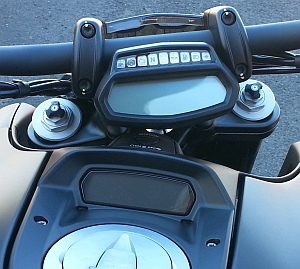
 There are two digital display panels: an LCD panel mounted on the handlebar, and a TFT colour display mounted on the tank, just in front of the filler-cap. The handlebar-mounted unit is the main one, giving clear readouts for speed and tacho, fuel level etc. The tank mounted one has displays for what gear you’re in, what engine mode you’re using, air temperature, battery voltage, fuel-consumption, trip meters, and a bunch of other stuff as well.
There are two digital display panels: an LCD panel mounted on the handlebar, and a TFT colour display mounted on the tank, just in front of the filler-cap. The handlebar-mounted unit is the main one, giving clear readouts for speed and tacho, fuel level etc. The tank mounted one has displays for what gear you’re in, what engine mode you’re using, air temperature, battery voltage, fuel-consumption, trip meters, and a bunch of other stuff as well.
 The wealth of information on display without having to push buttons to get there is great! I guess I’m just not used to looking in two different places to get it though; as I found looking at the tank-mounted panel a bit awkward. No doubt you’d get used to this though.
The wealth of information on display without having to push buttons to get there is great! I guess I’m just not used to looking in two different places to get it though; as I found looking at the tank-mounted panel a bit awkward. No doubt you’d get used to this though.
 It’s worth noting here too, that the oil-warning light warns against loss of oil-pressure; which is much better than the usual bike system that just warns of low oil level.
It’s worth noting here too, that the oil-warning light warns against loss of oil-pressure; which is much better than the usual bike system that just warns of low oil level.
 The engine comes from the 1198 Super-Sport, although re-tuned to suit its new role of course. The engine is now called the Testastretta 11 for the new 11-degree overlap in its valve timing. Overseas the power is quoted at 162hp (and I’m sure I saw “162” written on the side of the engine somewhere), but in Australia it loses a few horses, going down to 152. Torque goes down by a few Nm too. I doubt you’d notice the difference though: there's plenty of power without ever getting close to the maximum. The bike gives you three modes of operation: Sport, Touring and Urban. Sport gives full power and a snappy response, Touring gives full power but softens the response, and Urban cuts the power to about 100 horsepower.
The engine comes from the 1198 Super-Sport, although re-tuned to suit its new role of course. The engine is now called the Testastretta 11 for the new 11-degree overlap in its valve timing. Overseas the power is quoted at 162hp (and I’m sure I saw “162” written on the side of the engine somewhere), but in Australia it loses a few horses, going down to 152. Torque goes down by a few Nm too. I doubt you’d notice the difference though: there's plenty of power without ever getting close to the maximum. The bike gives you three modes of operation: Sport, Touring and Urban. Sport gives full power and a snappy response, Touring gives full power but softens the response, and Urban cuts the power to about 100 horsepower.
 According to the specs, the bike weighs in at 210kg dry (and minus the battery). But it feels way lighter than that! Yes, the wide bars would help, but it’s more than that: it obviously has a very low centre-of-gravity. That’s one advantage of cruisers, of course: they invariably have the weight carried down low, which make them feel lighter to handle. As someone once said about cruisers, you really only notice the weight when you have to push it uphill.
According to the specs, the bike weighs in at 210kg dry (and minus the battery). But it feels way lighter than that! Yes, the wide bars would help, but it’s more than that: it obviously has a very low centre-of-gravity. That’s one advantage of cruisers, of course: they invariably have the weight carried down low, which make them feel lighter to handle. As someone once said about cruisers, you really only notice the weight when you have to push it uphill.
OUT ON THE ROAD
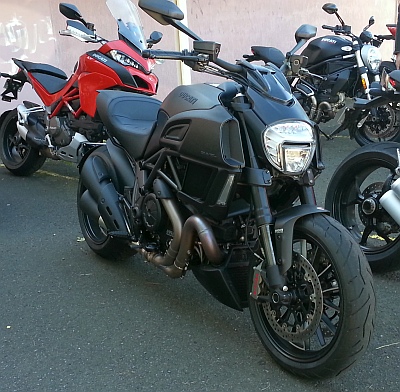
 This was only a short ride; a group ride, organised by the local dealer around suburban streets and distributor roads. There were no long twisty sections, no particularly rough sections, and not a lot of highway – although you could pretend the main distributor road was a highway for brief periods when you could see there weren’t radar guns lurking in the bushes! And there were a variety of corners to give an idea of handling capabilities. So, the ride was relatively short, but informative enough. I was offered a longer ride – “Come in and take it out on your own, go up the coast for a while and get a good feel for what it’s like!” – but I didn’t bother: I don’t think I would’ve enjoyed taking it on too long a ride.
This was only a short ride; a group ride, organised by the local dealer around suburban streets and distributor roads. There were no long twisty sections, no particularly rough sections, and not a lot of highway – although you could pretend the main distributor road was a highway for brief periods when you could see there weren’t radar guns lurking in the bushes! And there were a variety of corners to give an idea of handling capabilities. So, the ride was relatively short, but informative enough. I was offered a longer ride – “Come in and take it out on your own, go up the coast for a while and get a good feel for what it’s like!” – but I didn’t bother: I don’t think I would’ve enjoyed taking it on too long a ride.

 Start it up and there are vibes at idle, then on take-off it shudders unhappily if you don’t give it a heap of revs. I put it in Touring Mode – or I got the salesman to do that when he asked, and he pressed the appropriate buttons. (It can be changed on the fly too; you don’t have to stop to change modes). I wanted the full power (so I wasn’t going down to Urban Mode), but didn’t need to have all those 150-plus horses on a snappy leash for the riding we’d be doing. Touring Mode smoothes out the response (perhaps a bit too much to be really picky), but it’s ideal for touring, where smoothness is desirable.
Start it up and there are vibes at idle, then on take-off it shudders unhappily if you don’t give it a heap of revs. I put it in Touring Mode – or I got the salesman to do that when he asked, and he pressed the appropriate buttons. (It can be changed on the fly too; you don’t have to stop to change modes). I wanted the full power (so I wasn’t going down to Urban Mode), but didn’t need to have all those 150-plus horses on a snappy leash for the riding we’d be doing. Touring Mode smoothes out the response (perhaps a bit too much to be really picky), but it’s ideal for touring, where smoothness is desirable.
 It still took a bit of getting used to though. It felt high geared; but that was due to the engine characteristics. It was very unhappy (shuddering badly) at anything under 3000rpm, and didn’t really start to feel comfortable until 4000rpm. Keep going from there and it felt much happier. There's no redline on the taco (there’s a warning-light on the LCD panel), but I had it to around 7000rpm and at that it was quite smooth and pulling strongly. It is, after all, basically a sports-bike engine (even if Ducati talks about strong low-end torque in the sales blurb), and so it prefers to be revving. That meant that even at 90 - 95kph along a suburban distributor road, it was probably happiest in 4th. Change up to 5th and it was fairly content, although obviously not at its happiest section on the dial. But in top it was vibey and noticeably unhappy again. Top gear runs at 27 kph per 1,000rpm, and you probably need to be over 100kph to feel really comfortable in top. (Despite that, I mostly had it in top when riding along that more open section).
It still took a bit of getting used to though. It felt high geared; but that was due to the engine characteristics. It was very unhappy (shuddering badly) at anything under 3000rpm, and didn’t really start to feel comfortable until 4000rpm. Keep going from there and it felt much happier. There's no redline on the taco (there’s a warning-light on the LCD panel), but I had it to around 7000rpm and at that it was quite smooth and pulling strongly. It is, after all, basically a sports-bike engine (even if Ducati talks about strong low-end torque in the sales blurb), and so it prefers to be revving. That meant that even at 90 - 95kph along a suburban distributor road, it was probably happiest in 4th. Change up to 5th and it was fairly content, although obviously not at its happiest section on the dial. But in top it was vibey and noticeably unhappy again. Top gear runs at 27 kph per 1,000rpm, and you probably need to be over 100kph to feel really comfortable in top. (Despite that, I mostly had it in top when riding along that more open section).
 The gear-change is quite smooth, helped along by a slipper clutch.
The gear-change is quite smooth, helped along by a slipper clutch.
 There’s good power, of course – there’d want to be with all those ponies straining at the bit! When you twist the throttle it surges ahead: it isn’t brutal (flick to Sports Mode for that!), but it is quick! That’s when the super-sports heritage of the engine comes to the fore. Powering away from the lights, or accelerating out of a corner, or giving it a blast along an open stretch; that’s when it really starts to feel more sports-bike than cruiser.
There’s good power, of course – there’d want to be with all those ponies straining at the bit! When you twist the throttle it surges ahead: it isn’t brutal (flick to Sports Mode for that!), but it is quick! That’s when the super-sports heritage of the engine comes to the fore. Powering away from the lights, or accelerating out of a corner, or giving it a blast along an open stretch; that’s when it really starts to feel more sports-bike than cruiser.
 If it’s really a sports-bike in cruiser clothing, then it should handle, right? Well, yes, it should; and it does, but the cruiser clothing certainly affects it. There’s 28-degree rake on the front forks, and the back tyre is a 240-section; very much cruiser-type numbers. With the lazy steering and wide back tyre giving it typical cruiser-style reluctance to initial turn-in, and the engine still shaking, when I pulled out of the driveway onto the 4-lane city road, I wobbled away like an old grandfather! (Oh yeah …. that’s right; I am a grandfather!). The whole knees up, wide bars, and cruiser-ish handling took some getting used to. By the time we got back though, I was feeling more confident with it. Initially I found that, in typical cruiser style, cornering wasn’t just a matter of counter-steering, but required a more conscious lean of the bike into the corner, and then turn the bars. Later though, as I became more confident with it, I found that counter-steering did actually work.
If it’s really a sports-bike in cruiser clothing, then it should handle, right? Well, yes, it should; and it does, but the cruiser clothing certainly affects it. There’s 28-degree rake on the front forks, and the back tyre is a 240-section; very much cruiser-type numbers. With the lazy steering and wide back tyre giving it typical cruiser-style reluctance to initial turn-in, and the engine still shaking, when I pulled out of the driveway onto the 4-lane city road, I wobbled away like an old grandfather! (Oh yeah …. that’s right; I am a grandfather!). The whole knees up, wide bars, and cruiser-ish handling took some getting used to. By the time we got back though, I was feeling more confident with it. Initially I found that, in typical cruiser style, cornering wasn’t just a matter of counter-steering, but required a more conscious lean of the bike into the corner, and then turn the bars. Later though, as I became more confident with it, I found that counter-steering did actually work.
 The brakes felt good; the levers didn't require a lot of pressure to work, but they weren’t too grabby either.
The brakes felt good; the levers didn't require a lot of pressure to work, but they weren’t too grabby either.
 The ride was good on smooth roads, but a bit harsh on anything a little choppy; even bumps on the “highway” section felt quite harsh. However the suspension is fully adjustable at both ends, so you could do some fiddling there to get a better ride if you so desired. That’s what I like about having adjustable suspension, you can pick your own preference on the ride-versus-handling scale.
The ride was good on smooth roads, but a bit harsh on anything a little choppy; even bumps on the “highway” section felt quite harsh. However the suspension is fully adjustable at both ends, so you could do some fiddling there to get a better ride if you so desired. That’s what I like about having adjustable suspension, you can pick your own preference on the ride-versus-handling scale.
 So there it is. It has a very cruiser-ish look and feel to ride, but with much more power and the suspension tuned more towards stability and handling in corners – once you get used to it, anyway. So you can have a cruiser and not be limited in performance or having fun in the corners.
So there it is. It has a very cruiser-ish look and feel to ride, but with much more power and the suspension tuned more towards stability and handling in corners – once you get used to it, anyway. So you can have a cruiser and not be limited in performance or having fun in the corners.
 I suppose value-for-money is hard to evaluate when you’re looking at a Ducati, but still, 25 grand is a lot of money! Yes, I know that bikes like BMW’s R1200R (a naked, if not a cruiser), and similar, are getting up towards that sort of price, but still, it is a lot of money!
I suppose value-for-money is hard to evaluate when you’re looking at a Ducati, but still, 25 grand is a lot of money! Yes, I know that bikes like BMW’s R1200R (a naked, if not a cruiser), and similar, are getting up towards that sort of price, but still, it is a lot of money!
SNAPSHOT
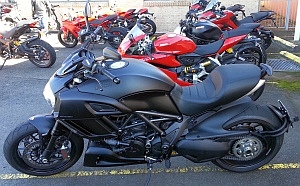
 A friend, Andrew, summed the bike up well when he said it was, “For those with an identity crisis; they don't know if they want a sports bike or a cruiser.” And that’s probably it in a nutshell.
A friend, Andrew, summed the bike up well when he said it was, “For those with an identity crisis; they don't know if they want a sports bike or a cruiser.” And that’s probably it in a nutshell.
 It looks like a cruiser, and in some respects rides and handles like a cruiser, but it has the go of a sports-bike: and once you learn how it handles, you could hustle it along through the corners too. I can imagine quite a few sports-bikes being surprised at the big black devil giving them a run-for-their-money; not only on the straights, but also through some twisties as well. Maybe it is, to adapt the old saying, Giovanni of both trades, master of neither.
It looks like a cruiser, and in some respects rides and handles like a cruiser, but it has the go of a sports-bike: and once you learn how it handles, you could hustle it along through the corners too. I can imagine quite a few sports-bikes being surprised at the big black devil giving them a run-for-their-money; not only on the straights, but also through some twisties as well. Maybe it is, to adapt the old saying, Giovanni of both trades, master of neither.
SPECIFICATIONS:
Engine: 2-cylinder, 1198cc. Power: 112kW at 9,000rpm. Torque: 123Nm at 8,000rpm.
Gearbox: 6-speed.
Final-drive: Chain
Suspension: Front: Marzocchi 50mm fork, fully adjustable. 120mm travel. Rear: Mono-shock, fully adjustable. 120mm travel.
Fuel capacity: 17 litres.
Weight: 210kg (dry).
Seat height: 770mm.
Wheels / Tyres: Front: 120 X 17. Rear: 240 X 17.
Brakes: Front: twin 320mm discs, with Brembo 4-piston calipers. Rear: Single 265mm disc, 2-piston caliper. ABS standard.
Price: $24,990 (+ORC).
Ridden: 2017.
Click here to go to the front page. Click your BACK button to return to the previous page.
